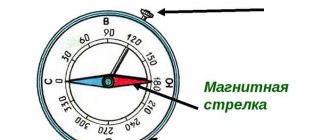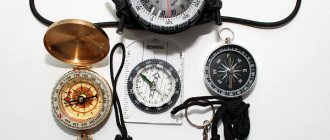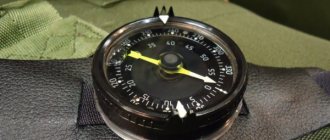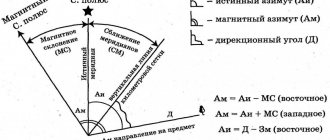Saturday, June 23, 2012
Magnetic compass
Every navigator, both in ancient times and in modern high-tech times, finding himself on the open sea out of sight of the shores, first of all wants to know in which direction his ship is moving.
An indispensable navigation device that can be used to calculate a ship's heading is a magnetic compass. Historians, as a result of lengthy research, have found that about three thousand years ago there was an analogue of the modern compass - a magnetic needle. In those days, the relationship between the populations of different countries was not so active, which is why only after several centuries, this wonderful invention - a direction indicator, appeared on the Mediterranean coast. Thus, the ancient compass appeared in Europe around the 2nd millennium AD. and only then did it spread to other lands. Guard: Have you decided to open a company? Need some advice? Details about turnkey IP registration. Contact the professionals.
Once in Europe, the device underwent many improvements and received the name that it still bears. The role of the compass in the development of humanity is enormous. Only the “magnetic needle” was able to instill in people confidence in safety on the “big water”. The sailors finally overcame their fear of the vastness of the ocean, knowing that in any case they would be able to find their way home. Not a single geographical discovery would have happened if this unique invention had not appeared in the world. Unfortunately, history has not preserved the name of the brilliant man who was able to come up with and show the world the prototype of the compass. Scientists were also unable to accurately determine the country in which this device was first registered. Although there are many opinions on this matter. Some believe that the Phoenicians were the first to pay attention to the unique property of magnets to stop in the region of the magnetic meridian. Others are inclined to believe that the discoverers were Chinese, while others claim that they were Arabs. There is even a theory that the invention of the magnetic compass belongs to the French, Normans, Italians, and some stubbornly argue that the creators of the compass are none other than the Mayan tribes, citing as evidence the fact that the prototype of the magnetic needle was found in Ecuador - a magnetic rod. The very first device for determining the cardinal directions was incredibly simple: a magnetic needle was stuck into a piece of cork and this structure was lowered into a bowl of water, which later became known as the “compass pot.” Sometimes a piece of reed or straw served as a substitute for a cork. But even such a simple invention brought incredible benefits to sailors. It became possible to go on long sea voyages and not think about the fact that you might not be able to return to your native shore. However, there were certain inconveniences: often during the trip, water poured out of the pot, and the needle readings were not always accurate. The sailors realized that the invention had not yet revealed all its possibilities to the world. Only six centuries later they came up with a compass that worked without water, thanks to a card attached to the arrow. A circle of small diameter, made of a material that does not interact with a magnet, together with a magnetic needle, was suspended on the thin tip of a vertical needle. Four main directions were drawn at the top: Zuid, West, Nord, Ost. The creators strictly ensured that Nord exactly coincided with the northern edge, which the tip of the arrow points to. The space between the main points was divided into equal parts. The card turned out to be a simple design and a great idea.
The compass was most skillfully made in Russia at the turn of the 17th and 18th centuries. A round box made of walrus ivory with a diameter of 5 centimeters was kept by the first Russian sailors - the Pomors - in a leather pouch on their belt. The device was reinforced with a bone pin and had a tight lid that prevented damage during movement. Today, the compass bowl is protected by a thick glass lid, which is carefully pressed by a copper ring. Markings are applied on top from 0 to 360 degrees clockwise from North. Inside the device, two copper wires are stretched parallel, one of which passes exactly under the division of 0 degrees, the other - under 180. They are also called course lines. On a ship, the compass must be installed so that the line between the heading lines exactly runs along the center line of the ship. In the nineteenth century, the magnetic compass finally acquired a design that has survived to this day almost unchanged. Humanity has made great progress in its knowledge of terrestrial magnetism. This led to a chain of new inventions and discoveries that, although not directly related to the compass, are still directly related to navigation. With the development of shipping, the requirements for the accuracy of instrument readings also grew. To the surprise of the sailors, the magnetic compass, which everyone trusted so much, could “lie” in the most brazen way. We noticed that compass errors are not the same in different places on Earth, that over the years they increase at some points and decrease at others, and that the closer to the pole, the greater these errors. In the 19th century, Carl Gauss, a German scientist, presented the general theory of magnetism to his colleagues, research was carried out and indications of the exact deviations of the instrument readings appeared on all navigation maps. Now the navigators have more work - after all, it has become necessary to determine the correction using compass readings. This was true only for mid-latitudes. In high latitudes, that is, in the areas from 70° northern and southern latitudes to the poles, the magnetic compass could not be trusted at all. The reason is that in these latitudes there are very large anomalies of magnetic declination, as the proximity of the magnetic poles, which do not coincide with the geographical ones, affects it. Shipbuilding continued to develop by leaps and bounds, metal steamships appeared, which quickly replaced wooden ships. But bad luck, the number of shipwrecks has increased for unknown reasons. Analyzing the circumstances of the disaster of one of the ships, experts determined that the cause of the accident was incorrect readings of the magnetic compass. Scientists and navigators gathered for a conference to clarify this issue. As a result of the negotiations, it was concluded that the metal from which sea vessels are built has a strong influence on the readings of the navigation instrument. The greater the mass of the vessel, the more the compass needle deviates from the meridian. The deviation of the magnetic compass needle under the influence of ship iron was called “deviation”. Opponents of the construction of iron ships became emboldened. But this time too, science saved the magnetic compass. The scientists placed special magnets next to the device, which destroyed the influence of ship iron, thus reducing the error to a minimum.
There is such a specially trained person - a deviator, whose task is to destroy deviation. Following his commands, the ship moves along different courses, and the specialist moves magnets and balls so as to reduce the influence of the ship's iron on the compass readings. As a result, the deviator leaves a special table of magnetic compass corrections, which the navigator must take into account. Nowadays, there are various types of navigational instruments such as gyrocompasses. Which provide incomparably higher heading accuracy and stability at high latitudes than a magnetic compass. But nevertheless, the authority of the magnetic compass did not decrease at all.
Labels: ship, navigation
Magnetic compass
Every navigator, both in ancient times and in modern high-tech times, finding himself on the open sea out of sight of the shores, first of all wants to know in which direction his ship is moving.
An indispensable navigation device that can be used to calculate a ship's heading is a magnetic compass. Historians, as a result of lengthy research, have found that about three thousand years ago there was an analogue of the modern compass - a magnetic needle. In those days, the relationship between the populations of different countries was not so active, which is why only after several centuries, this wonderful invention - a direction indicator, appeared on the Mediterranean coast. Thus, the ancient compass appeared in Europe around the 2nd millennium AD. and only then did it spread to other lands. Guard: Have you decided to open a company? Need some advice? Details about turnkey IP registration. Contact the professionals.
Once in Europe, the device underwent many improvements and received the name that it still bears. The role of the compass in the development of humanity is enormous. Only the “magnetic needle” was able to instill in people confidence in safety on the “big water”. The sailors finally overcame their fear of the vastness of the ocean, knowing that in any case they would be able to find their way home. Not a single geographical discovery would have happened if this unique invention had not appeared in the world. Unfortunately, history has not preserved the name of the brilliant man who was able to come up with and show the world the prototype of the compass. Scientists were also unable to accurately determine the country in which this device was first registered. Although there are many opinions on this matter. Some believe that the Phoenicians were the first to pay attention to the unique property of magnets to stop in the region of the magnetic meridian. Others are inclined to believe that the discoverers were Chinese, while others claim that they were Arabs. There is even a theory that the invention of the magnetic compass belongs to the French, Normans, Italians, and some stubbornly argue that the creators of the compass are none other than the Mayan tribes, citing as evidence the fact that the prototype of the magnetic needle was found in Ecuador - a magnetic rod. The very first device for determining the cardinal directions was incredibly simple: a magnetic needle was stuck into a piece of cork and this structure was lowered into a bowl of water, which later became known as the “compass pot.” Sometimes a piece of reed or straw served as a substitute for a cork. But even such a simple invention brought incredible benefits to sailors. It became possible to go on long sea voyages and not think about the fact that you might not be able to return to your native shore. However, there were certain inconveniences: often during the trip, water poured out of the pot, and the needle readings were not always accurate. The sailors realized that the invention had not yet revealed all its possibilities to the world. Only six centuries later they came up with a compass that worked without water, thanks to a card attached to the arrow. A circle of small diameter, made of a material that does not interact with a magnet, together with a magnetic needle, was suspended on the thin tip of a vertical needle. Four main directions were drawn at the top: Zuid, West, Nord, Ost. The creators strictly ensured that Nord exactly coincided with the northern edge, which the tip of the arrow points to. The space between the main points was divided into equal parts. The card turned out to be a simple design and a great idea. The compass was most skillfully made in Russia at the turn of the 17th and 18th centuries. A round box made of walrus ivory with a diameter of 5 centimeters was kept by the first Russian sailors - the Pomors - in a leather pouch on their belt. The device was reinforced with a bone pin and had a tight lid that prevented damage during movement. Today, the compass bowl is protected by a thick glass lid, which is carefully pressed by a copper ring. Markings are applied on top from 0 to 360 degrees clockwise from North. Inside the device, two copper wires are stretched parallel, one of which passes exactly under the division of 0 degrees, the other - under 180. They are also called course lines. On a ship, the compass must be installed so that the line between the heading lines exactly runs along the center line of the ship. In the nineteenth century, the magnetic compass finally acquired a design that has survived to this day almost unchanged. Humanity has made great progress in its knowledge of terrestrial magnetism. This led to a chain of new inventions and discoveries that, although not directly related to the compass, are still directly related to navigation. With the development of shipping, the requirements for the accuracy of instrument readings also grew. To the surprise of the sailors, the magnetic compass, which everyone trusted so much, could “lie” in the most brazen way. We noticed that compass errors are not the same in different places on Earth, that over the years they increase at some points and decrease at others, and that the closer to the pole, the greater these errors. In the 19th century, Carl Gauss, a German scientist, presented the general theory of magnetism to his colleagues, research was carried out and indications of the exact deviations of the instrument readings appeared on all navigation maps. Now the navigators have more work - after all, it has become necessary to determine the correction using compass readings. This was true only for mid-latitudes. In high latitudes, that is, in the areas from 70° northern and southern latitudes to the poles, the magnetic compass could not be trusted at all. The reason is that in these latitudes there are very large anomalies of magnetic declination, as the proximity of the magnetic poles, which do not coincide with the geographical ones, affects it. Shipbuilding continued to develop by leaps and bounds, metal steamships appeared, which quickly replaced wooden ships. But bad luck, the number of shipwrecks has increased for unknown reasons. Analyzing the circumstances of the disaster of one of the ships, experts determined that the cause of the accident was incorrect readings of the magnetic compass. Scientists and navigators gathered for a conference to clarify this issue. As a result of the negotiations, it was concluded that the metal from which sea vessels are built has a strong influence on the readings of the navigation instrument. The greater the mass of the vessel, the more the compass needle deviates from the meridian. The deviation of the magnetic compass needle under the influence of ship iron was called “deviation”. Opponents of the construction of iron ships became emboldened. But this time too, science saved the magnetic compass. The scientists placed special magnets next to the device, which destroyed the influence of ship iron, thus reducing the error to a minimum. There is such a specially trained person - a deviator, whose task is to destroy deviation. Following his commands, the ship moves along different courses, and the specialist moves magnets and balls so as to reduce the influence of the ship's iron on the compass readings. As a result, the deviator leaves a special table of magnetic compass corrections, which the navigator must take into account. Nowadays, there are various types of navigational instruments such as gyrocompasses. Which provide incomparably higher heading accuracy and stability at high latitudes than a magnetic compass. But nevertheless, the authority of the magnetic compass did not decrease at all. blog comments powered by Disqus
Next Previous Home page
Sailor's Handbook
- Published: 12/01/2013 12:27
- Seal
Contents of the material
- Sailor's Handbook
- All pages
Page 1 of 21
SAILOR'S REFERENCE BOOK
The section was created on the basis of the brochure “Sailor’s Reference Book” and other materials. The brochure was published in 1970 in the USSR, but much of it remains relevant even after more than 40 years...
CHARACTERISTICS AND SEAWORTHINESS OF THE VESSEL
The weight displacement of a ship is the weight of the water displaced by the ship. The volumetric displacement of a ship is the volume of the part of the ship's hull submerged in water. Lightweight displacement is the weight of the vessel with crew, supplies, water in the boilers (without cargo, fuel, fresh water and other voyage supplies). Fully loaded displacement is the weight of the ship with a full load, with all stores and crew. Deadweight, or the total carrying capacity of a ship, is the weight of the cargo, crew and all voyage supplies, i.e. the difference between the displacement of the ship when fully loaded and empty. Net carrying capacity is the weight of cargo that a ship accepts for transportation, i.e. deadweight minus the weight of fuel, water and all voyage supplies. Cargo capacity is the volume of all the ship's spaces used for cargo. For bulk cargo, the cargo capacity is on average 10% greater than for piece (general) cargo. Reserve buoyancy is the volume of the watertight surface part of the vessel, determined by the height of the freeboard. A load line is a mark located symmetrically on both sides of a ship and indicating the minimum freeboard in various conditions.
Load line; TP - tropical for fresh water; P - for fresh water; T - tropical; L - summer; W - winter; WSA - winter for the North Atlantic Ocean; LTP - forest tropical for fresh water.
Trim is the difference between the draft of the bow and stern of the vessel. Draft scales are marked on the ship's stems: on the starboard side in meters in Arabic numerals and on the left side in feet in Roman numerals.
Shaft draft marks: a - scale in feet; b - scale in decimeters
A small trim to the stern improves the working conditions of the propeller and the stability of the vessel on course; a large trim to the stern makes the vessel difficult to control. Stability is the ability of a ship to return to its original position after the force that causes it to tilt ceases. A vessel with excessive stability rolls rapidly. If the stability of the vessel is insufficient (below normal), there is a danger of capsizing. The stability of the vessel is affected by: the movement of cargo in the vertical direction, the reception and removal of cargo, as well as the presence of liquid, bulk and suspended cargo that can move when the ship tilts. For transport ships, it can be approximately assumed that when cargo is received above the load waterline, the stability of the vessel decreases, if below it increases. If liquid cargoes have a large free level surface, they reduce the stability of the vessel. Therefore, compartments for storing liquid fuel and water should be pressed in whenever possible or kept empty. Loose cargo with a free surface reduces stability. Suspended loads, especially heavy ones, also reduce the stability of the vessel. Unsinkability is the ability of a vessel to maintain sufficient seaworthiness even if part of the premises is flooded. Controllability is the ability of a vessel to maintain a given direction. FROM THE CHARTER OF SERVICE ON VESSELS OF THE USSR MARINE FLEET State flag of the USSR
State flag of the USSR
Protecting the State Flag of the USSR and maintaining its dignity is the honorable duty of every member of the ship’s crew. The state flag of the USSR is raised on the ship's stern flagpole while it is moored, and on the gaff while sailing, every day at 8 a.m. and lowered at sunset. Outside the established time, the flag must be raised: when entering and leaving a port, when meeting at sea with Soviet warships and merchant ships before diverging from them.
M/v "Kabona" of the Estonian Shipping Company in full parade of flags...
The raising and lowering of the State Flag of the USSR, as well as pennants, is carried out by order of the watch officer. Flags and pennants are raised unfurled. When meeting a USSR warship, the ship is obliged to greet it by lowering the State Flag once. When meeting at sea, commercial and fishing vessels of the USSR greet each other by lowering the State Flag once.
- Back
- Forward >>
- Back
- Forward











